Why Mosul’s Great Mosque of al-Nuri mattered
- Published
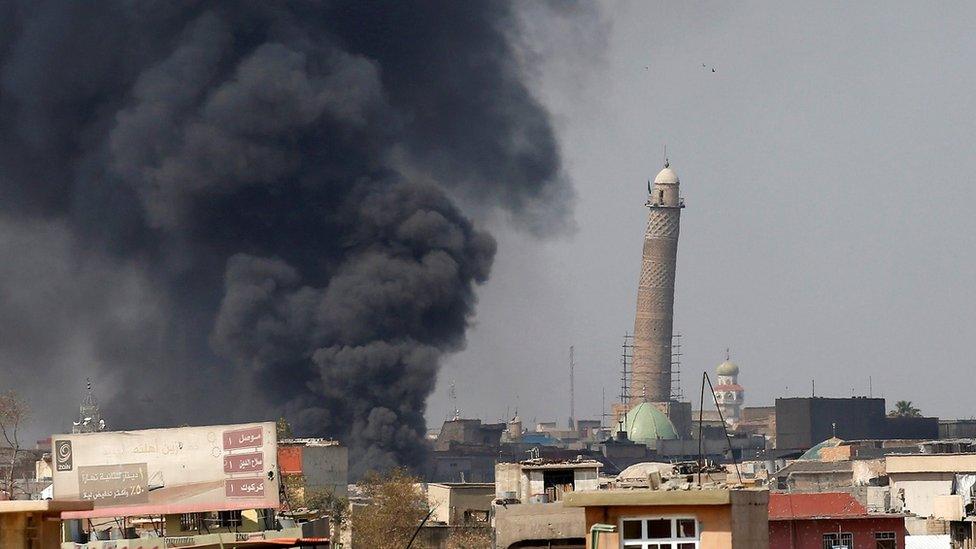
The black flag of so-called Islamic State was flown from the minaret during the battle for Mosul
The Great Mosque of al-Nuri in Mosul has been destroyed during fighting between government forces and the jihadist group Islamic State (IS).
The Iraqi military said militants had blown up the mosque and the leaning al-Hadba minaret, one of the most famous landmarks in the Old City, as troops advanced on it.
But IS accused the US-led coalition of destroying the mosque, which was also of great symbolic importance to both sides of the conflict.
It is where IS leader Abu Bakr al-Baghdadi made a rare public appearance in early July 2014 and gave a speech proclaiming the creation of a new "caliphate", only weeks after his fighters seized control of the city.

The Iraqi military provided this image showing the destruction at the mosque compound
The Great Mosque was named after Nur al-Din Mahmoud Zangi, a Turkic ruler of Mosul and Aleppo who ordered its construction in 1172, two years before his death.
Nur al-Din is famous for mobilising and unifying Muslim forces to wage jihad, or war in the path of God, against the Christian Crusaders.
During his 28-year rule, Nur al-Din captured Damascus and laid the foundations for the success of Saladin, who served as his commander in Egypt before founding the Ayyubid dynasty and retaking Jerusalem in 1187.
Nur al-Din is also revered by jihadists for his efforts to make Sunni Muslim orthodoxy prevail over Shiism.
Despite its connection to such an illustrious figure, all that remained, external from the original mosque was the leaning minaret, some columns and the mihrab, a niche indicating the direction of Mecca.
The cylindrical minaret was covered with elaborate brickwork inspired by Iranian designs and topped with a small, white-plastered dome.
At the time of its completion, the minaret was 45m (150ft) high, external. But by the time the Ibn Battuta, external visited Mosul in the 14th Century, the minaret was already leaning significantly and had acquired its nickname - "al-Hadba", or "the humpback".
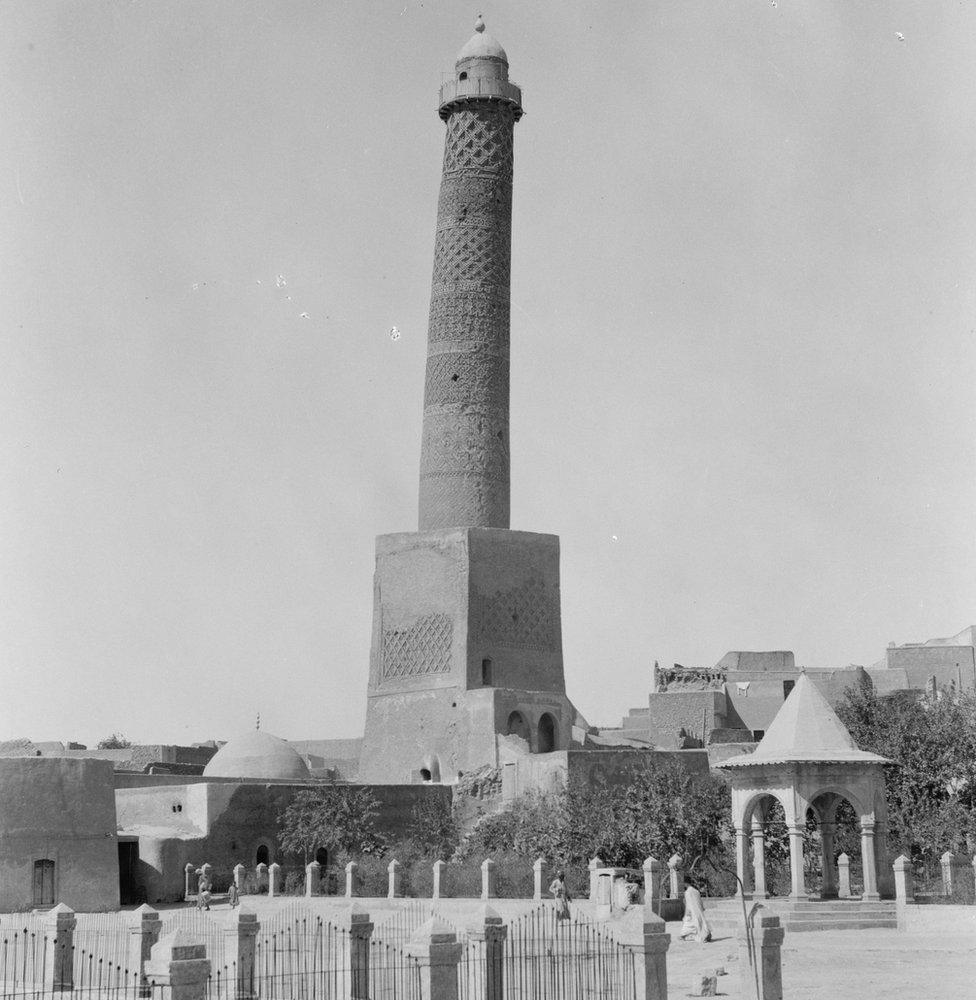
The Hadba minaret - pictured here in 1932 - had long been feared to be structurally unstable
The cause of the tilt was not fully known. According to local tradition, the minaret bowed to the Prophet Muhammad as he passed overhead while ascending to heaven, ignoring the fact that he died centuries before it was built.
But experts believe, external it was caused by the prevailing north-westerly winds, the effect of the sun on the bricks on the southern side, or the weak gypsum used to hold the bricks together.
Bombs that struck Mosul during the Iran-Iraq War also broke underground pipes near the base of the minaret, allowing sewage to collect in pools and weaken the foundations.
In 2012, the United Nations Educational, Scientific and Cultural Organization (Unesco) calculated, external that the minaret was leaning 2.5m (8.3ft) off the perpendicular axis, and warned it was suffering from serious structural weakness and at risk of collapse.
On 2 June 2014, the agency announced, external that it had begun a conservation programme with the Nineveh provincial government that was aimed at stabilising the minaret.
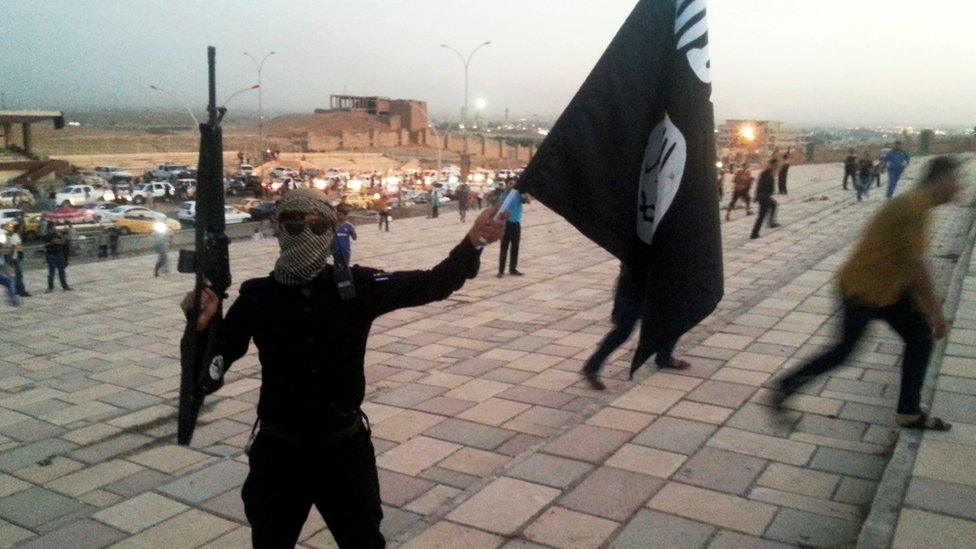
IS militants seized control of Mosul in June 2014 before advancing across northern Iraq
But later that week, deadly clashes erupted in Mosul as militants from what was then known as Islamic State in Iraq and the Levant (Isil or Isis) launched a surprise assault.
After overrunning the city, they swept southwards towards the capital Baghdad, seizing control of much of the provinces of Nineveh, Salahuddin and Diyala within a matter of days.
On 12 June, militants summarily killed the imam of the Grand Mosque, Mohammed al-Mansouri, for refusing to join them, according to the UN, external.
At the end of June, Isis formally declared the establishment of a "caliphate" - a state governed in accordance with Sharia by God's deputy on Earth, or caliph.
It named Abu Bakr al-Baghdadi as Caliph Ibrahim and demanded allegiance from Muslims worldwide. The group renamed itself Islamic State, dropping the mention of Iraq and the Levant.
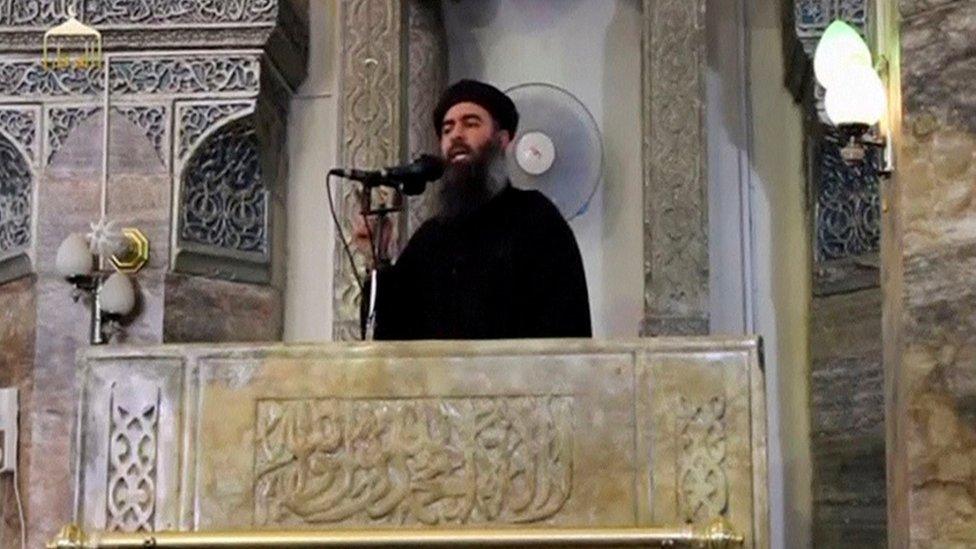
Abu Bakr al-Baghdadi made his first public appearance as IS leader at the mosque in July 2014
On 4 July, Baghdadi delivered a Friday sermon from the pulpit at the Great Mosque of al-Nuri - his first public appearance in many years.
Dressed in a black robe and black turban - a signal that he claims to be descended from the Prophet Muhammad's Quraysh tribe, a crucial qualification for the office - Baghdadi said he had reluctantly accepted the title of "commander of the faithful".
"God, the Great and Almighty, has bestowed upon your mujahideen brothers the grace of victory and conquest, and has enabled them to do that after long years of waging jihad, showing patience, and fierce fighting against the enemies of God," he added. "They have hurried to declare the caliphate and empower an imam. This is the duty imposed on the Muslims."
Echoing the inaugural address by the first caliph, his namesake Abu Bakr, Baghdadi stressed that he was "not the best among you", adding: "If you see that I am right, help me. However, if you see that I am wrong, advise and guide me."
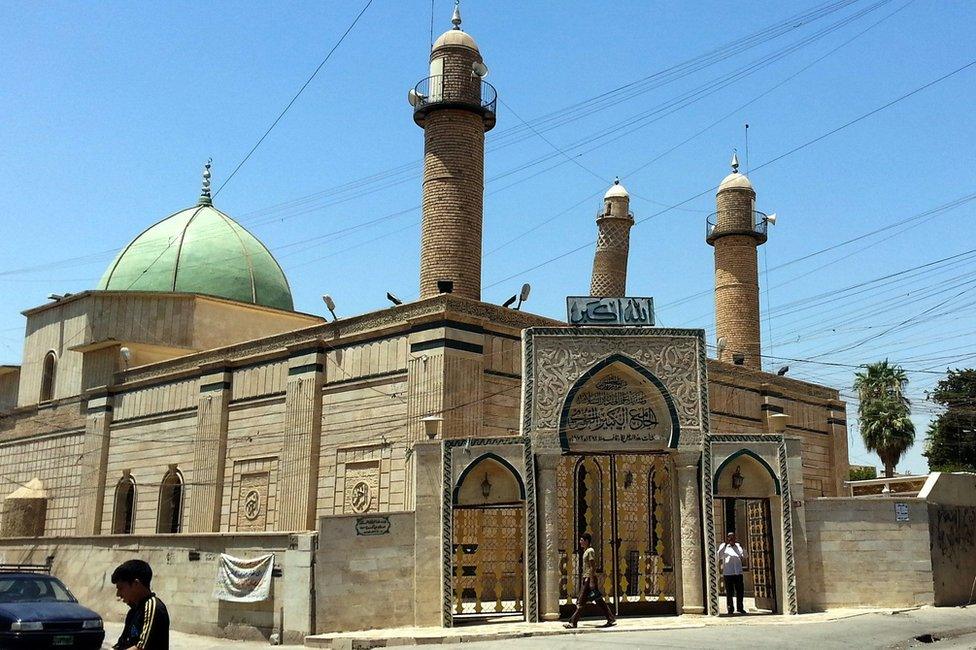
Mosul residents said IS first attempted to blow up the Hadba minaret soon after seizing the city
Mosul residents said the congregation were ordered to attend, external the Friday service, searched thoroughly on arrival and told where and how to sit.
And at the end of that month, residents complained that IS militants had attempted to blow up the Hadba minaret, external as part of an effort to destroy shrines and tombs revered by Muslims or non-Muslims that the jihadist group considers idolatrous.
Two residents said that when militants arrived at the Great Mosque carrying high explosives, a crowd rushed to the courtyard and linked arms to form a human chain around the minaret.
The Iraqi military circulated a video it says shows the destruction of Mosul's Great Mosque of al-Nuri.
The militants reportedly backed down and left once the witnesses warned the fighters: "If you blow up the minaret, you will have to kill us too."
The residents were sure the militants would return, but the minaret was still standing as Iraqi security forces moved towards it as part of an offensive to retake Mosul that was launched by the government in October 2016 with the US-led coalition air and ground support.
On Wednesday night, the Iraqi commander in charge of the offensive said elite Counter-Terrorism Service units had advanced to within 50m (165ft) of the mosque and minaret when IS militants "committed another historical crime" and blew it up.